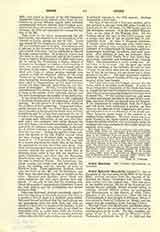

Codex Ephraemi Rescriptus (symbol C), last in the group of the four great uncial MSS. of the Greek Bible, received its name from the treatises of St. Ephraem the Syrian (translated into Greek) which were written over the original text. This took place in the twelfth century, the ink of the Scriptural text having become partially effaced through fading or rubbing. Several Biblical codices are palimpsests (see Manuscripts of the Bible), of which Codex Ephraemi is the most important. After the fall of Constantinople it was brought to Florence; thence it was carried to Paris by Catherine de’ Medici, and has passed into the possession of the National Library.
Through Pierre Alix, Montfaucon, and Boivin, attention was called to the underlying text, and some of its readings given to the world. The first complete collation of the N. T. was made by Wetstein (1716). Tischendorf published the N. T. in 1843 and the O. T. in 1845. The torn condition of many leaves, the faded state of the ink, and the covering of the original writing by the later made the decipherment an extremely difficult task; some portions are hopelessly illegible. Tischendorf, then a young man, won his reputation through this achievement. His results, however, have not been checked by other scholars, and so cannot yet be accepted without caution.
The codex, of good vellum, measures 12* inches by 9 inches; there is but one column to a page, C being the earliest example of this kind. The writing is a little larger than that of rt, A, and B; the first hand inserted no breathings or accents, and only an occasional apostrophe. The period is marked by a single point. Large capitals are frequent, as in A. The margin of the Gospels contains the Ammonian Sections, but not the numbers of the Eusebian Canons, which were probably written in vermilion and have faded away. . The Euthalian chapters are missing; the subscriptions are brief. From these indications and the character of the writing, Codex C is placed in the first half of the fifth century, along with A. Tischendorf distinguished two scribes (contemporaries), one for O. T., the other for N. T., and two correctors, one (Cs) of the sixth, the other (C’) of the ninth century; he conjectured that Egypt was the place of origin. With the exception of Tischendorf no modern has really studied the MS.
Originally the whole Bible seems to have been contained in it. At present, of the O. T. only some of the Hagiographa survive, in an imperfect state, namely nearly all of Ecclesiastes, about half of Ecclesiasticus and Wisdom, with fragments of Proverbs and Canticles—in all 64 leaves. About two-thirds of the N. T. (145 leaves) remain, including portions of all the books except II Thess. and II John; no book is complete. The text of C is said to be very good in Wisdom, very bad in Ecclesiasticus, two books for which its testimony is important. The N. T. text is very mixed; the scribe seems to have had before him MSS. of different types and to have followed now one now another.
JOHN F. FENLON

